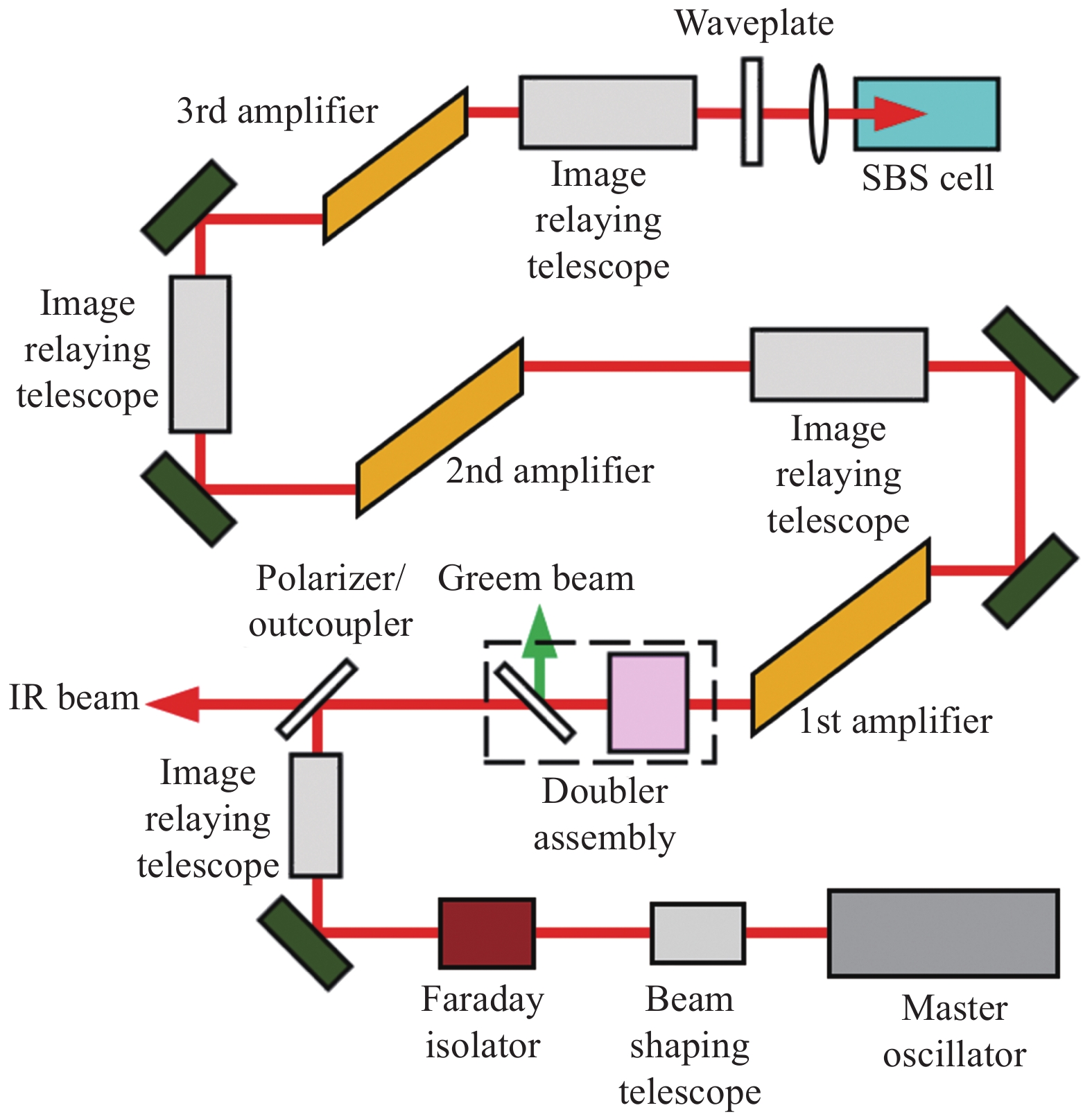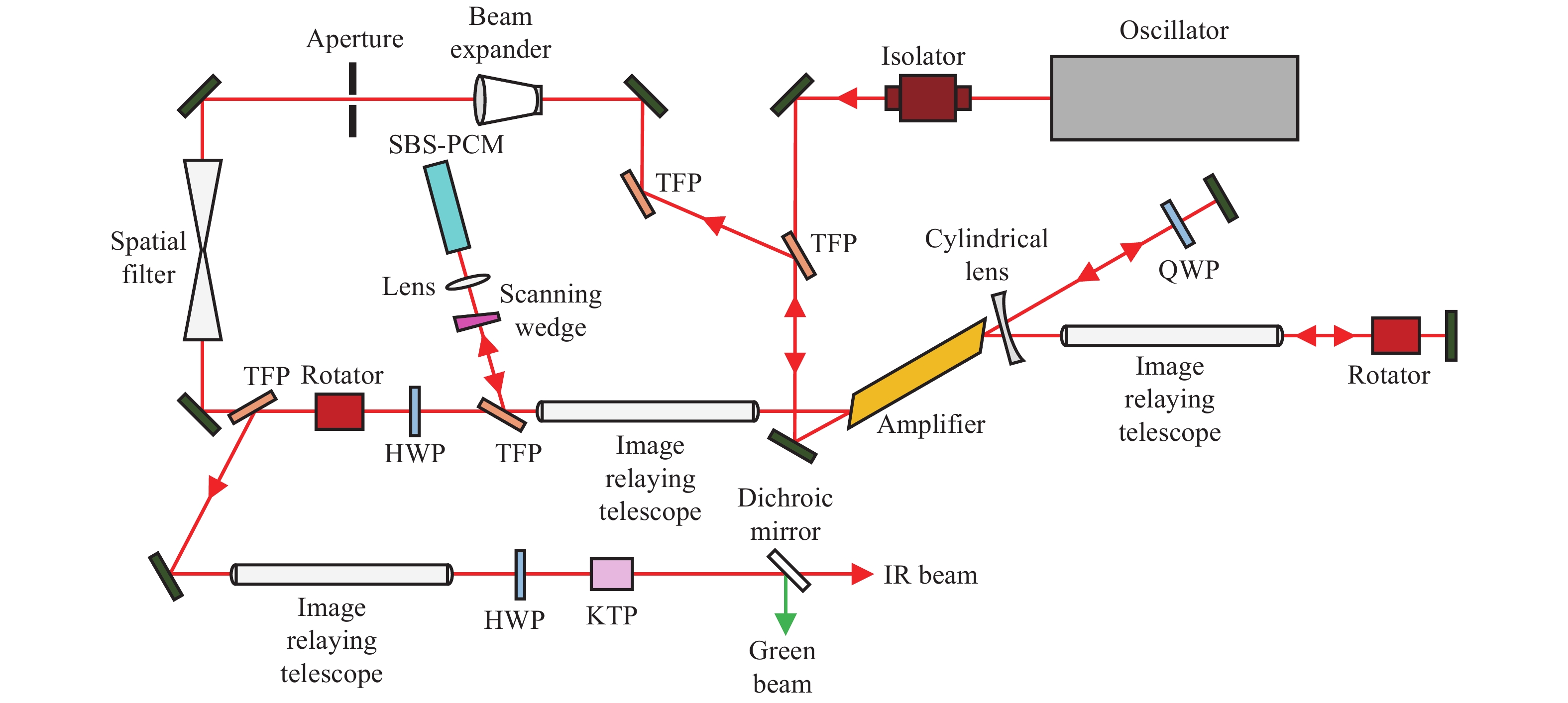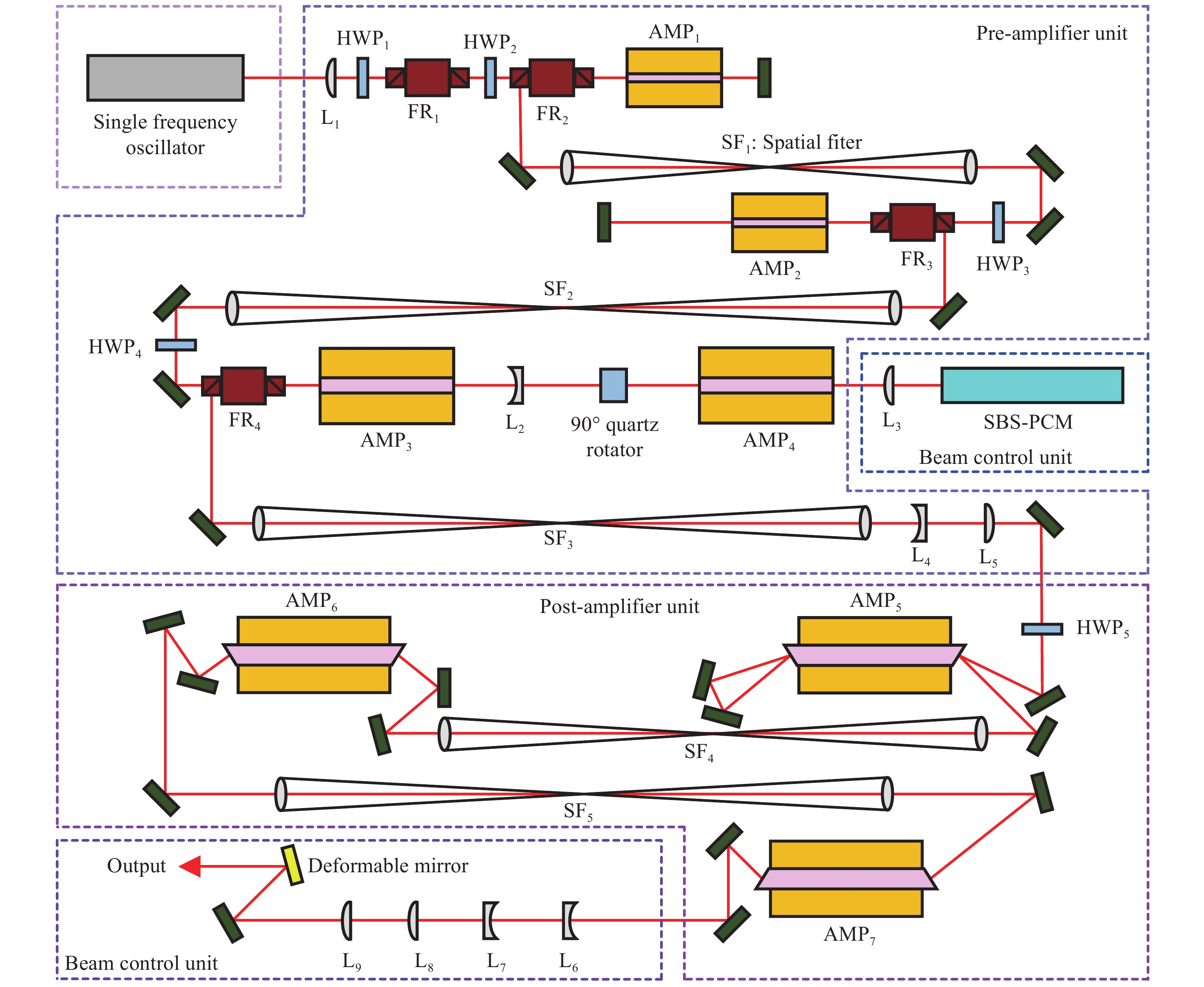-
高功率纳秒激光器在多普勒激光测风雷达[1-2]、空间碎片探测[3-4]、X射线产生[5]、汤姆逊散射诊断[6-7]及材料激光加工[8-9]等领域有着广泛应用,这些应用要求激光器在提升输出功率的同时能够保持良好的光束质量。为达到提升输出功率的目的,激光器中需要使用多级放大器及高能泵浦源,然而高能泵浦源引入的热积累会在晶体中形成热透镜效应和热致双折射效应,使激光器中传输的光束中存在明显的波前畸变,进而严重影响激光的光束质量[10]。为解决这一问题,人们提出了使用激光二极管(Laser Diode, LD)泵浦源以降低产热量和使用薄片、板条晶体以加快散热速率的方法[11-12]。尽管采用了LD泵浦、改良晶体构型和高效热管理技术,在高功率激光器中仍存在着严重的热积累和明显的波前畸变[13]。特别是对纳秒激光器而言,由于短脉冲激光对泵浦能量的提取能力较弱,未提取的泵浦能量将转化为晶体中的热积累,导致输出光束质量无法接近衍射极限[10]。
SBS-PCM结构简单,具有相位共轭特性和能够改善光束质量的优点[14],已在工业、科研等领域得到广泛应用[15-17],是一种解决高功率纳秒激光器中光束质量恶化问题的有效手段[18]。在高功率脉冲激光注入条件下,SBS-PCM的使用受到光学击穿和热效应的影响,限制了其在更高功率纳秒激光器中的应用。文中简要介绍了SBS-PCM的基本原理,对国内外研究进展及其在纳秒激光器中的典型应用情况进行了举例,对比了不同SBS-PCM介质的特性,最终总结了SBS-PCM进一步的发展方向。
-
布里渊散射(Brillouin Scattering)的概念源于20世纪20年代,L. Brillouin在研究液体中的光散射现象时发现除瑞利散射外,散射光中还有存在频移的成分[19]。这一理论在之后的研究工作中得到了验证,人们将这一发生在活性介质中的声波场对光波场的非弹性散射现象命名为布里渊散射。在当时还没有激光器这种高强度光源,布里渊散射现象十分微弱,因此人们没有十分关注这一现象。直至20世纪60年代,在激光器问世后,R. Y. Chiao等人[20]将激光注入晶体介质中并首次观测到受激布里渊散射现象,开启了人们对SBS进行详尽研究的篇章。
-
SBS是在活性介质中的抽运光波、声波与Stokes散射光波发生三波混频,并将抽运光波的能量向Stokes散射光波转移的过程[21]。当功率密度达到SBS阈值、频率为
${\omega _{\rm{p}}}$ 的抽运光入射至活性介质中时,由于电致伸缩效应使介质中产生频率为$ {\omega _{\rm{s}}} $ 的弹性声波。该声波引起介质密度随时间和空间发生周期性变化,进而使介质折射率呈现时域和空间上的周期性分布。这种折射率的周期性分布可以看作一个运动的声波光栅,对抽运光形成散射,产生频率为${\omega _{\rm{p}}} - {\omega _{\rm{s}}}$ 的Stokes散射光。在上述过程中,每湮没一个抽运光子就在介质中产生一个声子和一个Stokes光子,因此Stokes散射光不断增强,实现抽运光能量向Stokes散射光的转移。 -
相位共轭波是指在振幅、相位及偏振态三个方面互为时间反演的光波,在数学上可表示为将一个算符作用在光电场上,使其复振幅转变为其复共轭。
当一束抽运光入射至SBS-PCM中时,在一维慢变近似及忽略损耗的条件下,有如下关系式[14]:
式中:
${E_{\rm{L}}}({{{r}}_ \bot },{\textit{z}})$ 和${E_{\rm{S}}}({{{r}}_ \bot },{\textit{z}})$ 分别为抽运光场和Stokes散射光场;${k_{\rm{L}}}$ 和${k_{\rm{S}}}$ 分别为抽运光场和Stokes散射光场的波矢;$g({{{r}}_ \bot },{\textit{z}})$ 为SBS增益;${f_{n}}({{{r}}_ \bot },{\textit{z}})$ 为一组正交归一化函数组;${C_{n}}({\textit{z}})$ 和$B$ 分别为对${E_{\rm{S}}}({{{r}}_ \bot },{\textit{z}})$ 和${E_{\rm{L}}}({{{r}}_ \bot },{\textit{z}})$ 进行展开时的系数。若该抽运光具有一定的波前畸变,在Stokes散射光的传播过程中,${C_0}({\textit{z}})$ 比其他${C_{n}}({\textit{z}})$ 的增速都大,因此传播一段距离后只剩下系数为${C_0}({\textit{z}})$ 的项。观察公式(6)能够发现Stokes散射光是抽运光的理想相位共轭光,该散射光具有与抽运光同样的波前。 -
当一束光强达到SBS阈值且存在一定波前畸变的光束入射到SBS-PCM中时,将产生与抽运光波前具有相同畸变的声波,可等效为一变形的反射镜[22],该反射镜恰好使Stokes散射光的波前与入射光波前相同,形成入射光的相位共轭光。
以一束有理想平面波前的光束往返经过一具有不规则表面的晶体为例,其波前变化过程如图1所示,图中数字为波前位置的时间顺序,红色实线为向右传播的光束波前,绿色虚线为反射后向左传播的光束波前。可以看出,图1(a)中1处的波前无畸变,晶体的不规则表面使2处波前存在畸变,经普通反射镜反射后在3处形成镜像的波前畸变,再次经过晶体后在4处产生更明显的波前畸变;而在图1(b)中,SBS-PCM中产生的畸变声波使反射后的光束在3处有与2处相同的波前畸变,经过晶体后波前被还原,得到4处的无畸变光束。

Figure 1. Evolution of the wavefront as the beam pass a round trip through crystal with an irregular surface. (a) Reflected by plane mirror; (b) Reflected by SBS-PCM
因此,在激光器的多个放大器之后使用SBS-PCM对光束进行反射使其再次通过放大器,不仅能够实现双程放大以充分提取放大器的储能,还能够有效补偿放大器对光束造成的波前畸变以提升光束质量。
-
使用SBS-PCM对光束波前畸变进行实时补偿,能够有效解决纳秒激光器无法同时获得高的输出功率和良好的光束质量这一矛盾。因此美国、俄罗斯、法国、德国、日本、中国、澳大利亚和韩国等多个国家的研究机构陆续开展了大量对SBS-PCM的理论和实验研究工作。
-
SBS-PCM介质分为气体、液体和固体三类,其中气体介质主要有甲烷、稀有气体、N2和SF6等[23-25];液体介质主要有苯、丙酮和FC重氟碳等[26-28];固体介质主要有熔融石英玻璃、LAP、DLAP晶体和光纤等[29-31]。
气体介质在常压下的SBS增益系数较低,因此通常需要加压至几十甚至几百个大气压来增加增益系数、提升能量反射率[32],但高压气体的击穿阈值较低且装置安全性差,因此只在早期得到使用并逐渐被液体和固体介质取代。
液体介质具有SBS阈值低、声子寿命短、吸收系数小、SBS增益系数高和击穿阈值高等优点而得到广泛使用。苯和丙酮的液体介质有毒、挥发性强、易对环境造成污染,因此在近几年的研究和应用中已不再使用上述液体。FC系列全氟碳液体具有良好的化学稳定性[33],以FC-72和FC-75分子为例,其化学键四周被氟原子包围,氟原子的范德华半径为0.135 nm,能够严密包裹碳链,起到良好的保护作用[34];且全氟碳液体的光学吸收系数极低,通常为10−5 cm−1,吸收系数越低,对入射光能量的吸收越少,以上两点使以全氟碳液体为介质的SBS-PCM具有100~130 GW/cm2的击穿阈值[26],不易发生光学击穿现象,因此适用于高功率激光器。
熔融石英玻璃、K8玻璃和LAP等晶体介质有不污染环境和利于激光器全固化的优点,且SBS增益系数高,因此在大能量纳秒激光器中得到了较多应用。但这些晶体的击穿阈值较低,以LAP晶体为例,其击穿阈值约为20 GW/cm2(@18 ns)且发生击穿后易造成永久损伤,因此应用十分受限[35]。在众多固体介质中,光纤介质能够实现较长的相互作用距离并有效减小入射光束截面积,因此适用于千赫兹级重复频率的高平均功率、低峰值功率激光器中[30]。但现有研究中的光纤SBS-PCM能量反射率明显低于液体介质,对激光器整体输出功率有一定的限制,且光纤端面的损伤阈值较低[36],通常为2 GW/cm2左右[37],不利于在大能量、短脉宽激光器中的应用。
-
最早使用SBS-PCM进行光束质量优化的是俄罗斯Lebedev物理研究所的Zel’dovich和Popovichev等人[14]。1972年,该团队使用SBS-PCM对红宝石主振荡功率放大(Master Oscillator Power-Amplifier, MOPA)激光器中的波前畸变进行补偿,使输出光束的发散角从2.5 mrad降低至0.15 mrad。其实验装置如图2所示,从振荡器出射的激光经过畸变介质后入射至SBS-PCM,畸变波前经过反演再次经过畸变介质并得到有效补偿,因此能够使从振荡器出射的近衍射极限激光在双程放大后仍保持近衍射极限输出,使用偏振片和1/4波片进行光隔离和输出,该结构也是SBS-PCM在MOPA激光器中的典型结构。

Figure 2. Optical layout of MOPA system with SBS-PCM adopted by Zel’dovich et al[14]
带有SBS-PCM的高功率纳秒激光器的主要研究进展如表1所示,表中激光器输出能量(Output energy)和SBS-PCM注入能量(Input energy)仅针对重复频率较低的激光器进行列举。
Institute Year Properties of laser system Properties of SBS-PCM Ref. Output
power/WOutput
energy/JRepetition
rate/HzPulse
duration/nsBeam
qualityMedium Input
power/WInput
energy/JReflectivity
America TRW 1993 100 − 100 7 1.1 DL Freon 113 30.5 − 85% [27] 1997 690 − 2.5 k 20 1.1 DL − 200 − >90% [38] 1998 940 − 100 7.5 2 DL Liquid 100 − 98% [39] America LLNL 1995 150 25-30 6 14 1.25 DL CCl4 15 2.5 88% [40] Japan Osaka University 2003 362 − 1 k 29 1.2 DL FC-75 90 − 75% [41] 2004 368 − 50 50 1.5 DL FC-75 & FC-72 43 − 98% [42] 2012 766 − 100 − − FC-75 & FC-72 − − − [43] Germany Technische Universität Berlin 1997 104 − 100 90 − Fiber − − 50% [44] 2001 315 − 2 k − M2=2.6 Fiber − − − [30] Australia EOS 2017 800 − 170 20 M2~3 FC-770 153 − 95.2% [45] China HIT 2008 − 106.6 20 min per shot 20 − CCl4 − >30 ~60% [46] China ZJU 2011 42 − 1 k 1.5 M2~2.3 Fiber − − 50% [36] China AOE 2017 1 k − 200 6.6 1.7 DL FC-770 220 W − 98% [3] 2018 550 − 500 10 M2~2 FC-770 150 W − 92% [47] Table 1. Applications of SBS-PCM in high power nanosecond lasers
1998年,以色列Soreq原子能研究中心的Jackel等人[48]将以纯度为99.9%的高压甲烷气体为介质的SBS-PCM使用在高能量钕玻璃激光器中。当甲烷气体压强达到105 atm时,注入光脉宽为200 ns,最高注入能量可达5 J,饱和能量反射率为90%。在其研究中发现,提升介质气体的压强能够降低SBS的能量阈值并提升能量反射率,但同时会降低气体的击穿能量阈值,为避免击穿可使用长焦距透镜降低焦点处的能量密度。
2000年,日本大阪大学的Kmetik等人[49]在GEKKO-XII激光装置上进行了大能量SBS-PCM实验。使用FC-75重氟碳液体作为介质,并在超净环境下使用孔径25 nm的滤膜对FC-75进行过滤处理,制作了Φ90×2 000 mm的大口径SBS-PCM。实验中最大注入能量为73 J,饱和能量反射率超过90%且未发生击穿现象。其研究认为,杂质的加热和热致电离是光学击穿起始阶段的主要原因,此后大量的热释电子足以导致介质中的雪崩电离,因此对液体介质进行高效过滤能够有效提升SBS的击穿阈值。
随着激光器技术的发展及应用场景对激光器需求的提升,高功率纳秒激光器逐渐向高重复频率、高平均功率和高亮度的方向发展。因此研究人员也逐步开始将SBS-PCM应用于高重复频率、高平均功率的纳秒激光器中。20世纪90年代,美国TRW公司的Pierre等人对带有SBS-PCM的MOPA结构高重复频率高平均功率纳秒激光器进行了大量研究工作[27, 39, 50],并获得了很多标志性的成果。
1993年,Pierre等人[27]使用LD阵列泵浦Nd3+:YAG板条晶体的MOPA激光器和SBS-PCM,实现了单脉冲能量1 J、重复频率100 Hz、平均功率100 W、光束质量1.1 DL的激光输出。其SBS-PCM采用氟利昂作为介质,这是世界上首套采用液体介质SBS-PCM实现百瓦级平均功率的激光器。
1997年,Pierre等人[38]使用带有SBS-PCM的MOPA结构激光器获得了平均功率690 W、重复频率2.5 kHz、光束质量1.1 DL的激光输出,这是目前为止带有SBS-PCM的激光器在高于千赫兹的重复频率下获得的最高平均功率。其光路如图3所示,SBS-PCM的注入光平均功率高达200 W,因此在SBS-PCM前放置了扫描楔形镜(Scanning Wedge)进行光束扫描,使光束焦点位置在SBS-PCM介质中旋转,以降低高功率注入光引入的热效应。

Figure 3. Optical layout of 690 W laser system developed by Pierre et al[38]
1998年,Pierre等人[39]研制了如图4所示的激光器,该激光器能够在33 Hz和50 Hz的重复频率下输出单脉冲能量10 J的激光,对应光束质量分别为1.25 DL和1.5 DL,在100 Hz重复频率下能够输出平均功率940 W、光束质量2 DL的激光。其SBS-PCM能够在50 Hz重复频率下承载100 W的注入光功率,且能量反射率高达98%。该激光器是首套输出平均功率能够达到近千瓦的带有SBS-PCM的高光束质量激光器。
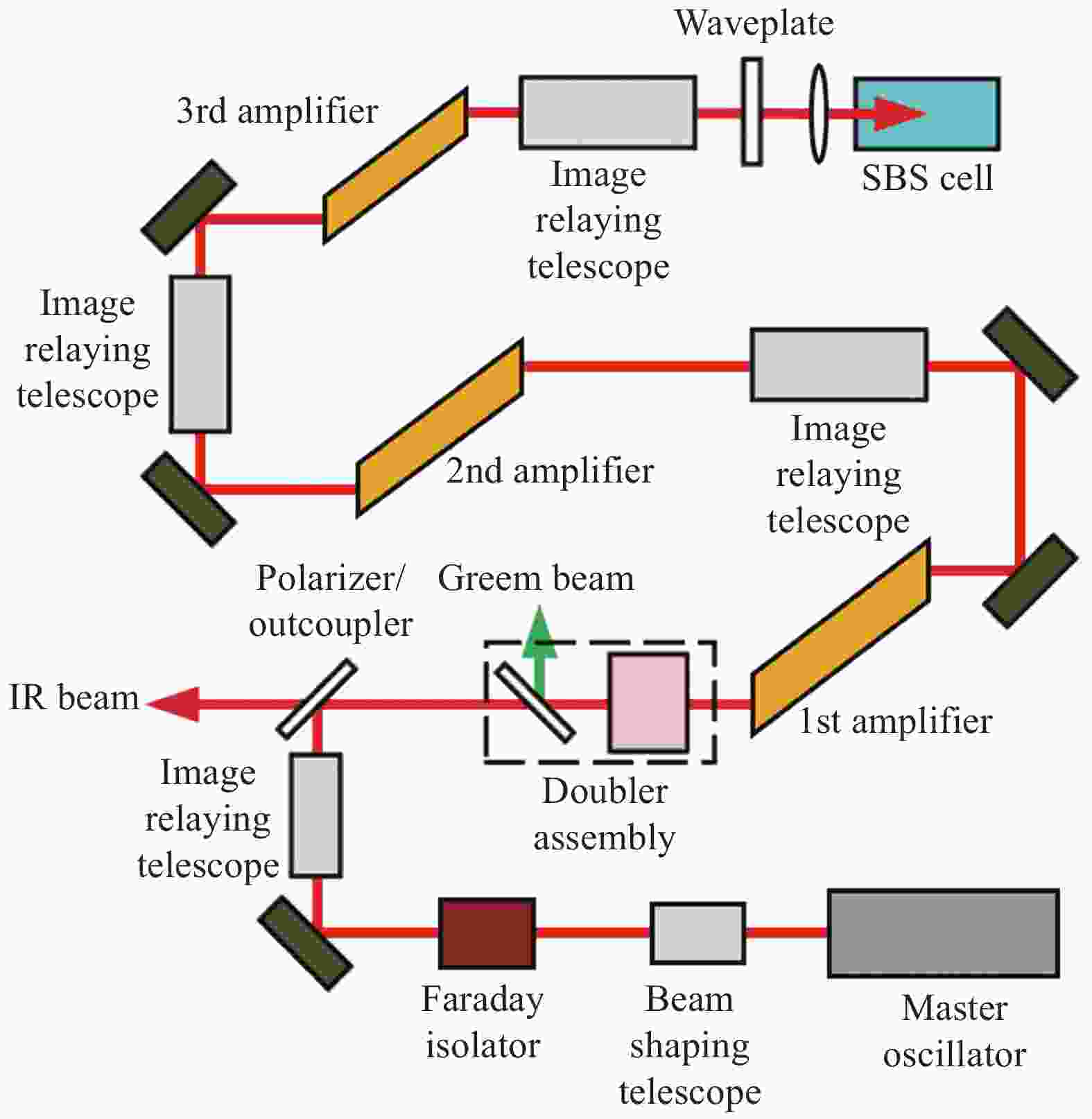
Figure 4. Optical layout of 940 W laser system developed by Pierre et al[39]
日本大阪大学的Yoshida等人针对液体SBS-PCM介质的选择开展了大量研究工作,并发现FC-72和FC-75等重氟碳液体具有很高的光学击穿阈值,在紫外至红外的宽光谱范围内吸收系数很小,且SBS增益系数大、化学性质稳定,是作为SBS-PCM介质的理想选择[26]。此后,诸多机构开展了大量以重氟碳液体作为SBS-PCM介质的研究工作[42-43, 51-54]。
2005年,日本原子能研究所的Kiriyama等人[41]研制了如图5所示的激光器,该激光器能够在1 kHz重复频率下输出平均功率362 W的激光,其SBS-PCM使用的介质为FC-75,可承载最高注入功率约90 W,能量反射率为75%。
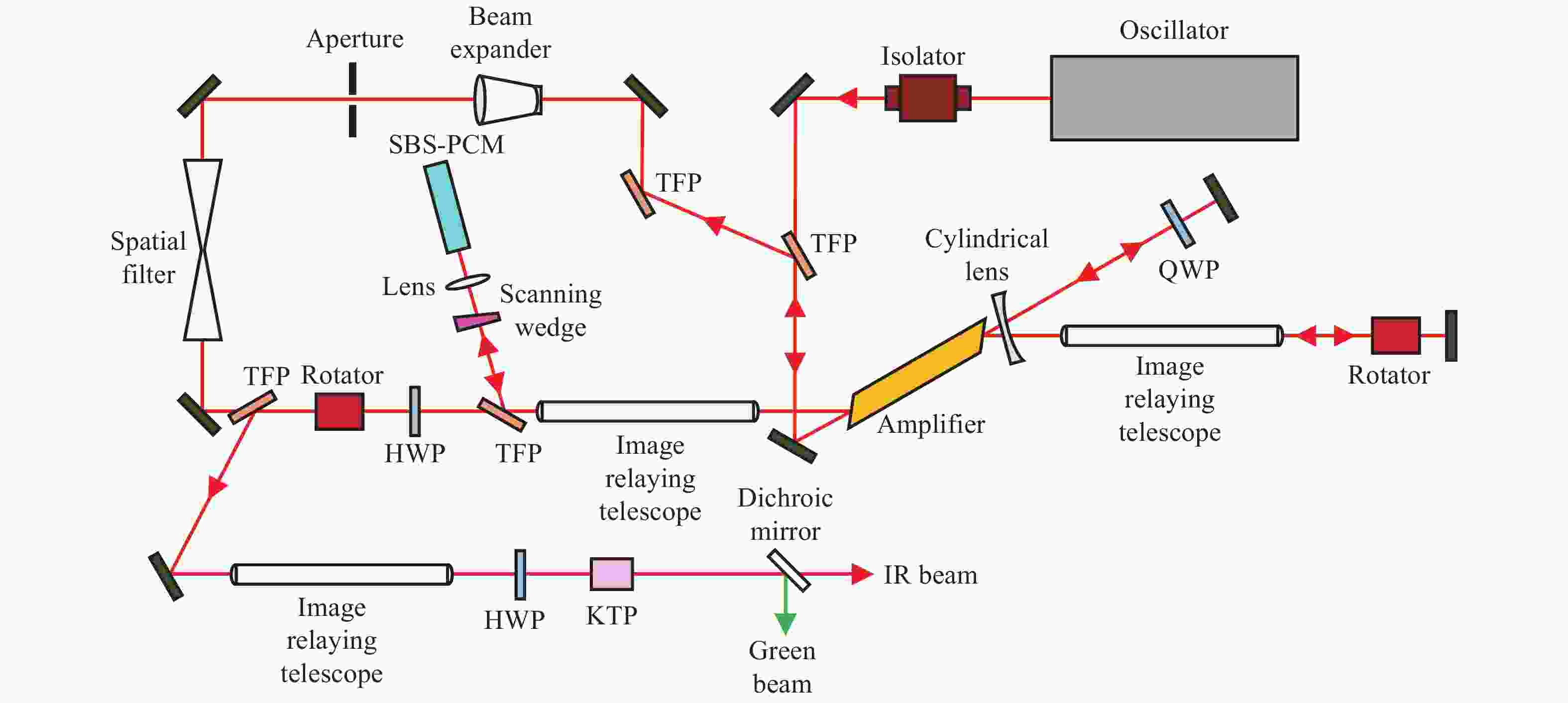
Figure 5. Optical layout of 362 W laser system developed by Kiriyama et al[41]
2012年,Yoshida等人[43]以FC-72和FC-75作为SBS-PCM的介质,研制了重复频率100 Hz、平均功率766 W的高水平激光器,如图6所示,其输出激光分为两束,两个放大链路中均使用SBS-PCM进行畸变补偿,放大后的平均功率分别为398 W和368 W。
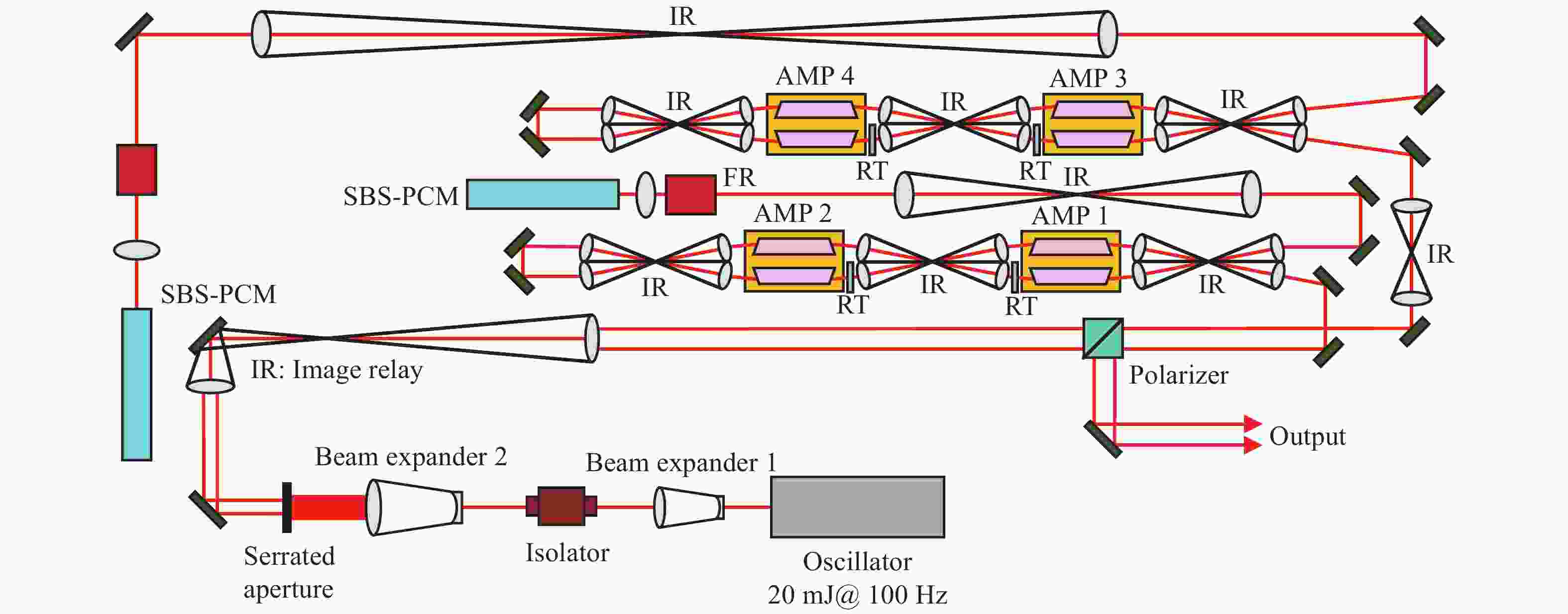
Figure 6. Optical layout of 766 W laser system developed by Yoshida et al[43]
2017年,澳大利亚EOS的Gao等人[45]研制了重复频率170 Hz、平均功率约800 W、光束质量因子M2~3的高功率激光器,其SBS-PCM使用FC-770为介质,注入功率约为153 W,能量反射率达到95.2%。
德国柏林工业大学的Eichler等人对以光纤为介质的SBS-PCM开展了大量研究工作[44, 55-56],并于1997年[44]首次将光纤SBS-PCM应用于MOPA结构的Nd3+:YALO激光器中,获得了重复频率100 Hz、平均功率104 W的激光输出,其SBS-PCM的能量反射率达50%以上。
2001年,Eichler等人[30]利用如图7所示的激光器中获得了平均功率315 W、重复频率2 kHz、光束质量因子M2=2.6的激光输出。在该激光器中,种子光被分为两束分别进行放大并均使用SBS-PCM进行畸变补偿,然后通过偏振合束合为一束。

Figure 7. MOPA system with fiber SBS-PCM developed by Eichler et al[30]
我国对SBS-PCM技术的研究起步较晚,主要研究机构为哈尔滨工业大学、浙江大学、中国科学院光电研究院、华北光电技术研究所和中国工程物理研究院等单位[52, 54, 57-59]。
哈尔滨工业大学对SBS-PCM的研究主要聚焦于大能量激光器上,2008年,王雨雷等人[46]将CCl4作为SBS-PCM介质并进行了百焦耳激光器搭建,其激光器光路如图8所示,SBS-PCM可承载的注入能量超过30 J,能够有效补偿放大器RA70-1中的热畸变,改善光束质量。整体装置能够在每20 min输出一次平均能量为106.6 J的激光,且进场光斑强度分布均匀,有良好的光束质量。
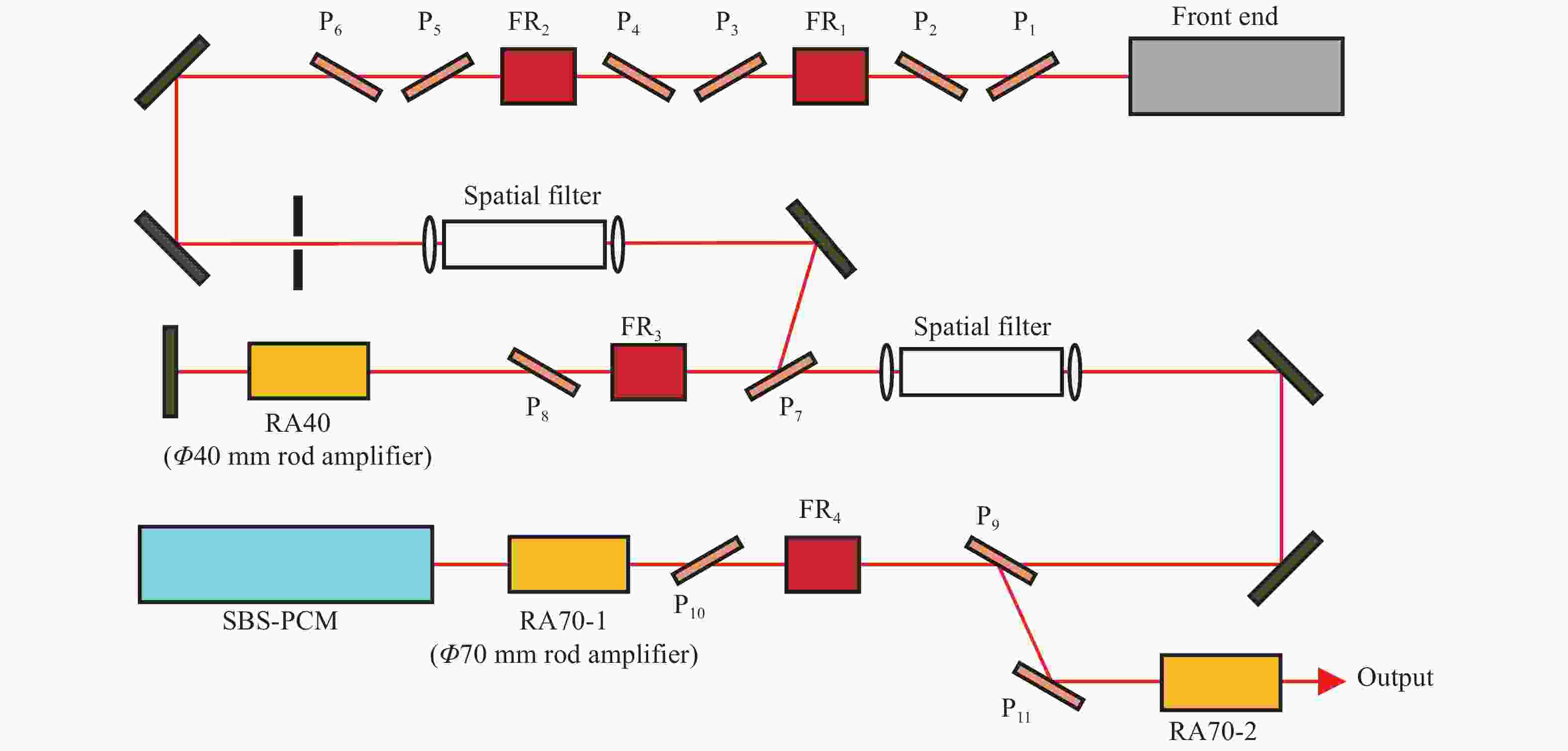
Figure 8. Optical layout of 100 J level laser system developed by Wang et al[46]
浙江大学在光纤SBS-PCM方面进行了大量研究工作,2011年,赵智刚等人[36]使用前端直径1 mm、尾端直径0.4 mm的锥形光纤作为SBS-PCM,对双通放大MOPA激光器进行了光束质量优化。其装置如图9所示,能够在1 kHz的重复频率下输出平均功率42 W、光束质量因子M2~2.3的激光。

Figure 9. Schematic diagram of the experimental setup adopted by Zhao et al[36]
中国科学院光电研究院着手于以FC重氟碳液体作为介质的高负载SBS-PCM研究工作,并取得了显著的成果。2017年,樊仲维等人[3]研发了可用于汤姆逊散射诊断的高平均功率激光器,在200 Hz重复频率下能够输出平均功率1 kW、光束质量1.7 DL的高质量脉冲激光,该激光器的输出平均功率及光束质量达到了同类激光器的领先水平。其光路如图10所示,SBS-PCM采用FC-770作为介质,种子光经过Pre-amplifier unit的功率放大和Beam control unit的畸变补偿后,平均功率达到60 W,而后经过AMP5~AMP7三级板条放大器将平均功率进一步提升至1 kW。可以看到SBS-PCM只对AMP3和AMP4两级放大器进行了热畸变补偿,可能的原因是SBS-PCM的可承载功率有限,因此若能进一步提升SBS-PCM的可承载功率,使其在光路中的位置向后级移动以补偿更多级放大器中的热畸变,结合合理的放大器增益配比,有望在保持同水平输出平均功率的同时获得更好的光束质量。

Figure 10. Optical layout of 1 kW laser system developed by Fan et al[3]
2018年,康治军等人[47]使用SBS-PCM研制了如图11所示的可用于空间碎片探测的高平均功率激光器,能够在500 Hz重复频率下输出平均功率550 W、光束质量因子M2~2的激光脉冲。其SBS-PCM用于补偿Postamplifier unit 1中四级放大器的热畸变,可承载注入光功率达150 W,能量反射率为92%,介质采用高效过滤后的FC-770,能够有效避免光学击穿的发生。
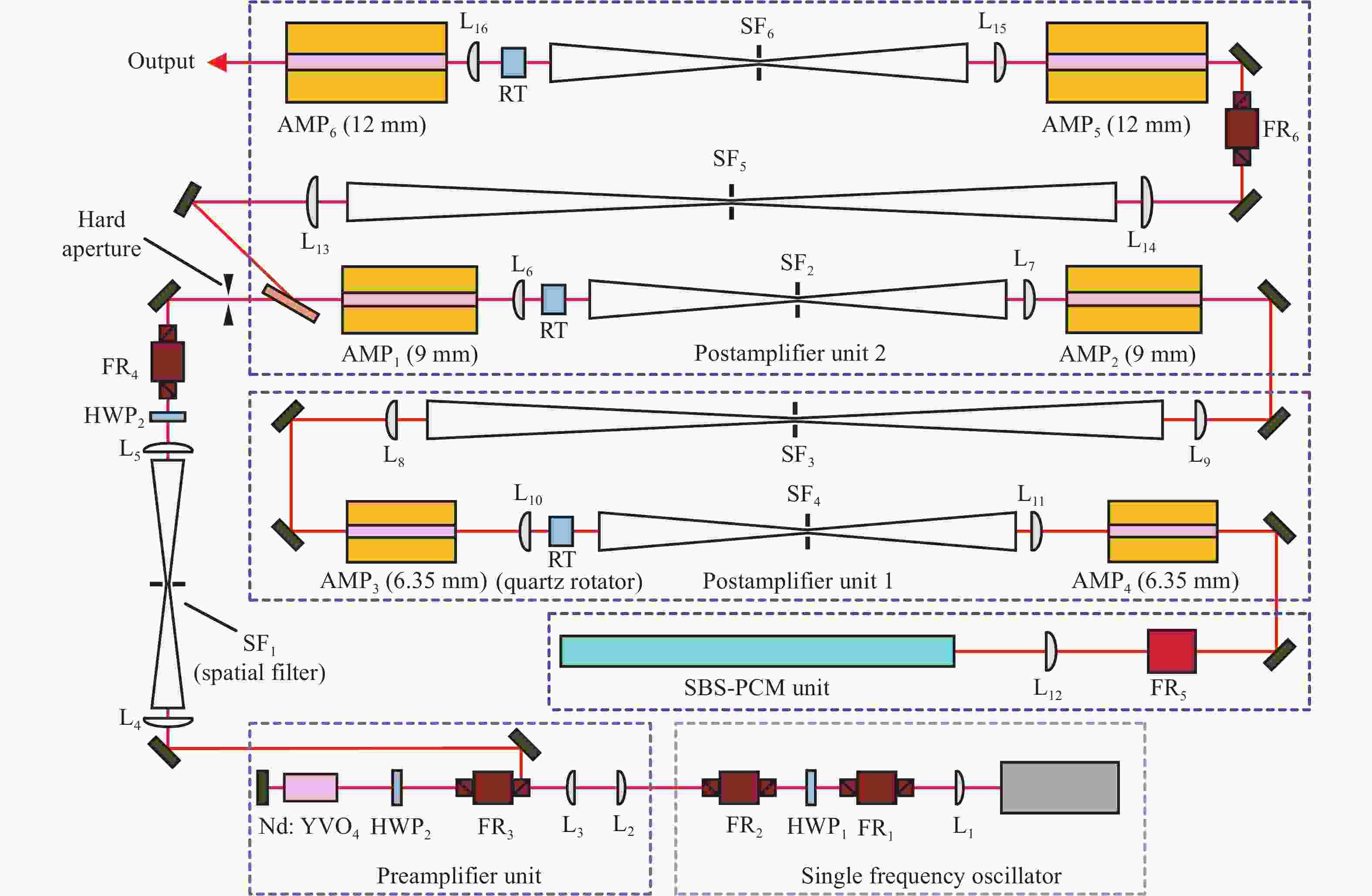
Figure 11. Optical layout of 550 W laser system developed by Kang et al[47]
-
SBS-PCM具有相位共轭特性,能够实时补偿激光放大器中的波前畸变,因此广泛应用于高光束质量的高功率激光器中,目前带有SBS-PCM的激光器的平均功率和重复频率分别可达到千瓦和千赫兹量级,并能够保持良好的光束质量。在诸多SBS-PCM的介质中,气体介质由于SBS增益系数低且安全性差已被逐渐取代;固体介质易发生永久损伤,只有光纤仍较为广泛地被用作SBS-PCM介质,尤其适用于重复频率千赫兹量级的激光器中,但其端面损伤阈值较低,现有研究中的注入光单脉冲能量多为几十豪焦以下[33],因此不适用于单脉冲能量较大的激光器;而以重氟碳为代表的液体介质具有化学性质稳定、吸收系数极低、击穿阈值和SBS增益系数高等诸多优点,因此被广泛应用于高重复频率、高平均功率激光器中。
目前,液体介质SBS-PCM的主要瓶颈是高注入光功率引发的热效应会影响装置运行的稳定性。为此,通常采用光束扫描[60]或循环介质[61]的动态工作方式和高效过滤介质[47, 54]的静态工作方式。其中动态工作方式将明显增加装置的复杂程度,削弱了SBS-PCM结构简单的优点,且额外的机械、电机结构也会降低装置的稳定性。而静态工作方式的难点主要在介质的过滤工艺上,封装后不会对激光器增添复杂性,因此优化提纯工艺或开发具有更好光学特性和热特性的介质将成为国内外对SBS-PCM的研究热点。
Application progress of the stimulated Brillouin scattering phase conjugate mirror in high power nanosecond lasers
doi: 10.3788/IRLA20211024
- Received Date: 2020-12-21
- Rev Recd Date: 2021-01-25
- Publish Date: 2021-05-21
-
Key words:
- lasers /
- stimulated Brillouin scattering /
- phase conjugate mirror /
- high power laser
Abstract: Stimulated Brillouin Scattering (SBS) is a third-order nonlinear optical effect, the reflected beam of which has the property of phase conjugation. The reflected beam is time inversed on amplitude, phase and polarization with the incident beam and maintains the same wavefront as the incident light. In the Master Oscillator Power Amplifier (MOPA) nanosecond laser system, the thermal effect in the laser amplifiers and a large number of optical elements in the optical path cause serious wavefront distortion of the transmitted beam, which not only deteriorates the beam quality, but also limits the possibility of further power improvement. Stimulated Brillouin Scattering Phase Conjugate Mirror (SBS-PCM) is utilized widely in this kind of laser system for the fact that using SBS-PCM by making the beam transmit along a round trip in amplifiers which bring in serious wavefront distortion compensates the distortion in real time, therefore is capable of optimizing the beam quality and improving the output power, so as to promote the development of nanosecond laser system in the direction of both high power and high beam quality. In this paper, the basic principle and phase conjugation characteristics of SBS-PCM were briefly introduced theoretically. Then the characteristics and application scope of different SBS-PCM media were compared. The research progress by domestic and foreign institutions on SBS-PCM and the typical application and development process of SBS-PCM in high power nanosecond lasers were summarized. Finally, the development trend of SBS-PCM was prospected.



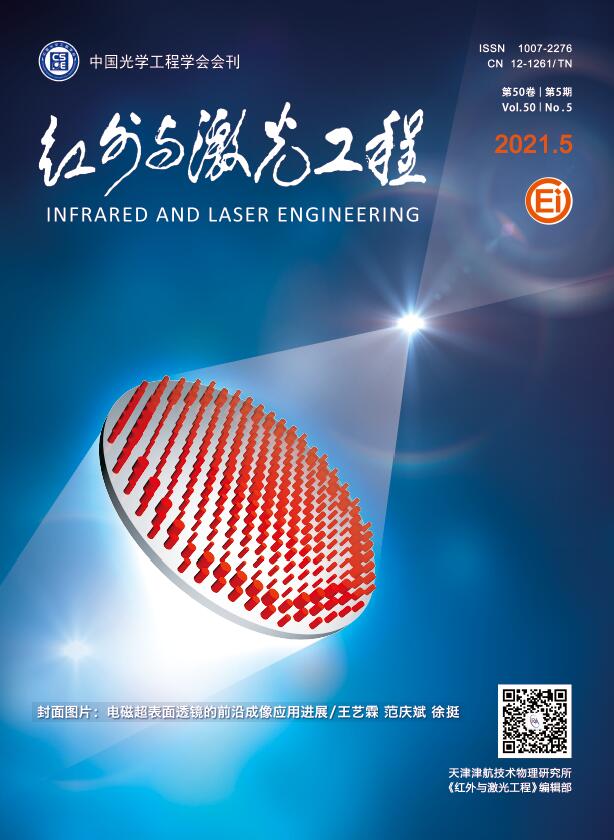






















 DownLoad:
DownLoad:


